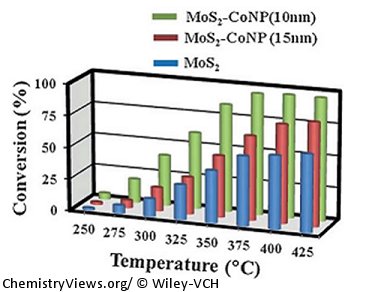Hydrodesulfurization is one of the most important processes in the petrochemical industry. It has to be necessarily carried out to make petroleum fuels useful for running automobiles and for other purposes. Hydrodesulfurization requires catalysts which are efficient in decomposing sulfur compounds such as thiophene to hydrocarbons. For example, thiophene will have to be decomposed into butane.
C. N. R. Rao, Jawaharlal Nehru Centre for Advanced Scientific Research, Bangalore, India, and co-workers found that by using MoS2 containing only two or three layers, transformation of thiopene into butane was much better than with bulk MoS2. This is further improved when nanoparticles of cobalt and nickel are deposited on the few-layer MoS2 (see graph).
This finding could be helpful in an industry setting.
- Hydrodesulfurization of Thiophene over Few-Layer MoS2 Covered with Cobalt and Nickel Nanoparticles
Bolla Govinda Rao, H. S. S. Ramakrishna Matte, Piyush Chaturbedy, C. N. R. Rao,
ChemPlusChem 2013.
DOI: 10.1002/cplu.201300012




